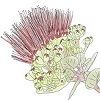10.2: Polynesian introduced plants
- Page ID
- 59270
Polynesian Introductions are plants introduced by early Polynesians who migrated to the Hawaiian islands from other islands in the Pacific. The history of Polynesian migration is well documented through archeological, linguistic, and DNA studies as well as through oral histories passed on through generations. Humans started to migrate eastward from Southeast Asia and Melanesia around 3,500 years ago (Kirch, 2010). They initially migrated to islands that were relatively easier to get to, as ocean levels were lower at this time. As they moved east, the distance between islands became greater and the biodiversity decreased. This meant the technology for successful voyaging had to become more advanced, such as the development of double-hulled canoes that could withstand longer journeys in open water. The dependency on domesticated plants and animals also increased because more distant islands did not have wild plants and animals that could be used for food and other survival means, compared to islands closer to Asia.
Polynesians arrived in Hawai‘i around 800 years ago (Kirch, 2010) and brought with them approximately 23 species of plants (Table 1). These plants were incredibly important, as they ensured the survival of the newly established human populations. While the first arrivals could survive for a time on native bird populations and seafood, successful human settlements depended on the successful introduction and production of domesticated agricultural crops (Kirch, 2010; Figure \(\PageIndex{1}\)).

The plants introduced by Polynesians did not all arrive at the same time, as there were multiple trans-oceanic voyages to and from the Hawaiian Islands. For example, ‘ulu (Artocarpus altilis, Figure \(\PageIndex{2}\)) arrived much later, and voyages to acquire it are well documented through oral histories.

‘Uala or sweet potato (Ipomea batatas, Figure \(\PageIndex{3}\)) was very likely acquired by Polynesians who traveled by canoe from islands in the Pacific Ocean to South America where this plant was first domesticated by indigenous people there.

These plants were part of highly sophisticated agricultural systems developed over time and passed on from generation to generation. For more information regarding traditional agricultural systems in Hawai‘i, see Lincoln and Vitousek (2017).
| Common Name(s) | Species |
| Kukui/Candlenut | Aleurites moluccana |
| ‘Ape | Alocasia macrorrhizos |
| ‘Ulu/Breadfruit | Artocarpus altilis |
| Wauke | Broussonetia papyrifera |
| Kamani | Calophyllum inophyllum |
| Niu/Coconut | Cocos nucifera |
| Kalo/Taro | Colocasia esculenta |
| Kī/Ti | Cordyline fruticosa |
| ‘Ōlena/Turmeric | Curcuma longa |
| Uhi | Dioscorea alata |
| Hoi | Dioscorea bulbifera |
| Pi‘a | Dioscorea pentaphylla |
| ‘Uala/Sweet potato | Ipomea batatas |
| Ipu | Lagenaria siceraria |
| Noni | Morinda citrifolia |
| Mai‘a/Banana | Musa spp. |
| ‘Awa | Piper methysticum |
| Kō/Sugarcane | Saccharum officinarum |
| ‘Ohe/Bamboo | Schizostachyum glaucifolium |
| ‘Ōhi‘a ‘ai/Mountain apple | Syzygium malaccense |
| Pia | Tacca leontopetaloides |
| ‘Auhulu/Fish poison | Tephrosia purpurea |
| ‘Awapuhi/Shampoo ginger | Zingiber zerumbet |
| Unknown origin (native and/or Polynesian Introduced): | |
| Hau | Hibiscus tiliaceus |
| Hala | Pandanus tectorius |
| Milo | Thespesia populnea |
*Based on Whistler (2009).


